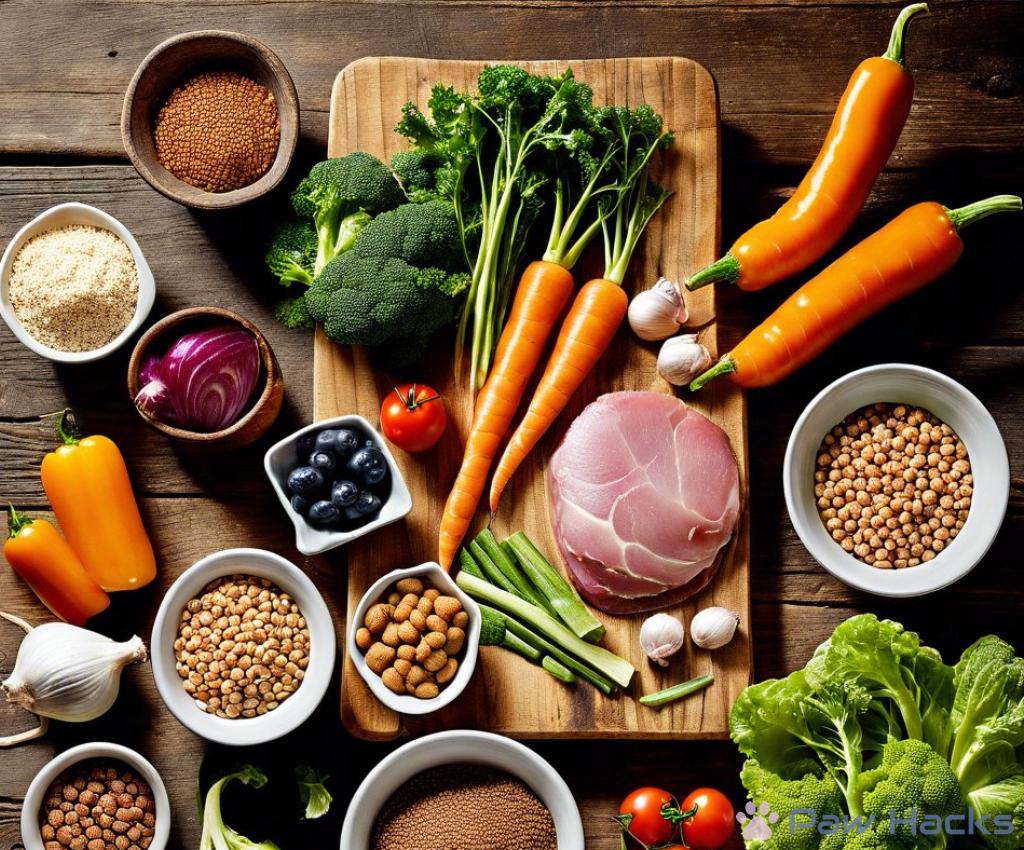Feeding Tips for Pets with Gastrointestinal Issues
Choosing the Right Food: A Guide for Sensitive Stomachs

Understanding Gastrointestinal Sensitivities
When it comes to our furry friends, a happy tummy is crucial for their overall well-being. Pets with gastrointestinal issues often suffer from discomfort, leading to lethargy and a lack of appetite. Choosing the right food can be a game changer for these pets, helping to ease their symptoms and improve their quality of life. This guide will help you navigate the complex world of pet food options tailored for sensitive stomachs.
Nutritional Considerations for Sensitive Stomachs
When selecting food for pets with sensitive stomachs, there are several key nutritional factors to consider. These factors can significantly influence how well your pet digests their food and absorbs nutrients. The right balance of ingredients can lead to a happier, healthier pet.
- Limited Ingredients: Foods with fewer ingredients can reduce the risk of food sensitivities. Look for formulas that list a single protein source and minimal fillers.
- High Digestibility: Choose foods that are easy to digest; this often includes pre-cooked or hydrolyzed proteins.
- Probiotics: These beneficial bacteria can help restore gut health and improve digestion.
- Fiber Content: A moderate amount of fiber can support healthy digestion and regular bowel movements.
Top Recommended Foods for Sensitive Stomachs
To make your decision easier, we’ve compiled a list of some of the best food options available for pets with gastrointestinal sensitivities. Each of these products is known for its quality ingredients and positive reviews from pet owners.
| Brand | Type | Key Ingredients |
|---|---|---|
| Hill’s Science Diet | Dry Food | Chicken, Brown Rice, Pea Fiber |
| Royal Canin | Canned Food | Chicken, Fish Oil, Rice |
| Blue Buffalo | Grain-Free | Turkey, Sweet Potatoes, Peas |
| Wellness Simple | Dry Food | Salmon, Potatoes, Peas |
These brands have been highly rated by pet owners for their effectiveness in managing gastrointestinal issues. Remember to transition your pet gradually to any new food to avoid further digestive upset.
Understanding Portion Control: Feeding Your Pet the Right Amount
When it comes to managing gastrointestinal issues in pets, understanding portion control is just as important as selecting the right food. Feeding your pet the appropriate amount can significantly influence their digestive health and overall well-being. Overfeeding can lead to additional discomfort and exacerbate gastrointestinal problems, while underfeeding may not provide the necessary nutrients for recovery. Therefore, determining the right portion size is crucial for your pet’s health.
Recognizing Your Pet’s Needs is the first step in establishing effective portion control. Each pet is unique, and factors such as size, age, activity level, and specific gastrointestinal conditions must be taken into account when deciding how much to feed. Consult your veterinarian to develop a tailored feeding plan that aligns with your pet’s individual requirements. This professional guidance can help ensure that your pet is getting balanced nutrition without overwhelming their sensitive system.
Monitoring Your Pet’s Response to their diet is another essential aspect of managing portion control. After adjusting their meal sizes, observe any changes in their behavior, energy levels, and digestive health. Signs that your pet may be receiving too much food include bloating, lethargy, or diarrhea. Conversely, if they seem constantly hungry, it may indicate that they are not getting enough. Keeping a journal of your pet’s reactions can help identify patterns and inform future feeding decisions.
Using a measuring cup to portion out meals can also promote consistency and prevent overfeeding. This simple practice ensures that you are feeding your pet the right amount based on the guidelines provided by your veterinarian. Additionally, consider dividing their daily food intake into smaller, more frequent meals. This approach can help ease digestion and reduce the strain on your pet’s gastrointestinal system.
Lastly, always remain flexible and willing to adjust your pet’s portions as needed. Their nutritional needs may change over time due to various factors, including weight fluctuations, changes in health status, or variations in activity levels. Staying attuned to these shifts will enable you to provide the best care for your furry friend.
The Importance of Hydration: Keeping Your Pet Comfortable
When dealing with gastrointestinal issues, hydration plays a crucial role in your pet’s comfort and recovery. Often overlooked, proper hydration helps to facilitate digestion and can alleviate some of the discomfort associated with gastrointestinal problems. Just as food choices are vital, ensuring your pet drinks enough water is also essential for their overall health.
The body’s ability to digest food efficiently is closely linked to its hydration levels. When pets are dehydrated, their bodies struggle to break down food, which can lead to further gastrointestinal distress. This is especially true for pets with sensitive stomachs, as they may be more prone to complications if their fluid intake is inadequate. Therefore, encouraging your pet to drink water should be a priority.
Recognizing Signs of Dehydration
It’s important to be aware of the signs of dehydration in pets. Common indicators include excessive thirst, dry gums, lethargy, and decreased skin elasticity. If you notice any of these symptoms, it may be time to increase your pet’s water intake. You can help keep your pet hydrated by offering fresh water regularly, and consider adding wet food to their diet, as this can provide additional moisture.
Creative Ways to Encourage Fluid Intake
Sometimes pets can be picky about drinking enough water, especially if they associate it with discomfort from their gastrointestinal issues. To encourage your pet to stay hydrated, try offering water in different types of bowls or using a pet water fountain. Many pets are attracted to running water and may drink more from a fountain than a stationary bowl. Additionally, you can enhance the flavor of their water by adding a small amount of low-sodium broth. This can entice even the fussiest drinkers to stay hydrated.
It’s also beneficial to monitor your pet’s water intake to ensure they are drinking enough throughout the day. If you notice a significant decrease, consult your veterinarian to rule out any underlying health concerns. By making hydration a priority, you can help your pet feel more comfortable and improve their overall digestive health.
Introducing New Foods: A Step-by-Step Approach
When it comes to pets with gastrointestinal issues, introducing new foods can feel like navigating a minefield. The process requires careful planning and sensitivity to your pet’s unique dietary needs. Making changes too quickly can lead to digestive upset, which is the last thing you want for your furry friend. This guide will help you implement a gradual approach to food transitions, ensuring your pet’s comfort while exploring new dietary options.
Understanding the Transition Process
Transitioning your pet to new food doesn’t just happen overnight. The key to a successful transition is gradual change. This method allows your pet’s digestive system to adjust without overwhelming it. Start by mixing a small amount of the new food with their current diet. Over the course of several days, you can slowly increase the proportion of the new food while decreasing the old. This gradual blending minimizes the risk of gastrointestinal distress and helps your pet adapt smoothly to the new taste and texture.
Monitoring Your Pet’s Reaction
As you introduce new foods, it is essential to closely observe your pet’s reaction to the changes. Keep an eye out for any signs of discomfort, such as diarrhea, vomiting, or excessive gas. If you notice any adverse reactions, it may be a sign that the new food is not suitable for your pet’s sensitive stomach. In such cases, it’s advisable to revert to the previous diet and consult your veterinarian for further recommendations. Your pet’s health and comfort should always be your top priority, and patience during this transition can lead to successful outcomes.
Additionally, maintaining a journal of your pet’s eating habits and digestive responses can provide valuable insights. This tracking can help you identify which foods agree with your pet and which do not. By paying attention to these details, you can make informed choices that will ultimately benefit your pet’s overall well-being.
When to Seek Help: Recognizing Serious Gastrointestinal Problems
Understanding the Signs that Require Immediate Attention
As a responsible pet owner, you play a crucial role in monitoring your furry friend’s health, particularly when they are facing gastrointestinal troubles. It can be challenging to determine when minor digestive upset escalates into a serious condition. Recognizing the warning signs can be the difference between a quick resolution and a more severe health crisis. Being proactive is essential in ensuring your pet receives the care they need.
Identifying Severe Symptoms
While occasional digestive issues like mild vomiting or soft stools may not cause alarm, specific symptoms warrant immediate veterinary intervention. For instance, if your pet exhibits persistent vomiting, especially if it contains blood or resembles coffee grounds, this could indicate a more serious underlying issue. Similarly, if your pet experiences severe diarrhea lasting more than a day or appears to be in pain while defecating, these are red flags that should not be ignored.
Another critical sign is abdominal swelling or bloating. This could signal a condition known as gastric torsion or bloat, which is a life-threatening emergency. Additionally, if your pet is lethargic, refuses to eat for over 24 hours, or exhibits signs of dehydration, such as dry gums or skin tenting, it’s time to seek veterinary help. Monitoring your pet’s behavior and taking note of any deviations from their norm is vital in these situations.
When in Doubt, Consult a Professional
It’s essential to remember that your intuition as a pet owner is invaluable. If you feel something is off with your pet’s digestive health, it’s always better to err on the side of caution. Reach out to your veterinarian for guidance, as they can provide expert insight and conduct necessary examinations. Don’t hesitate to ask questions or express concerns about your pet’s condition; after all, you know them best.
In conclusion, vigilance is key in managing your pet’s gastrointestinal health. By recognizing serious symptoms and seeking prompt medical attention, you can help ensure your furry companion remains happy and healthy. Your proactive approach not only improves their quality of life but also fosters a deeper bond built on trust and care.
Share this content:



